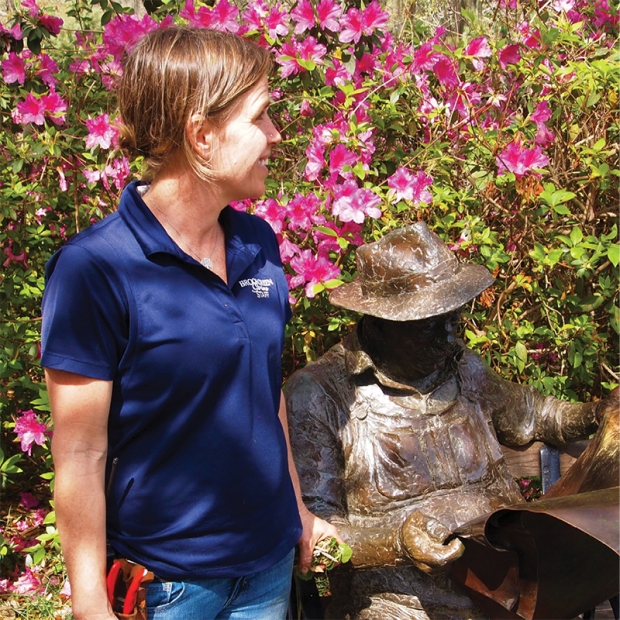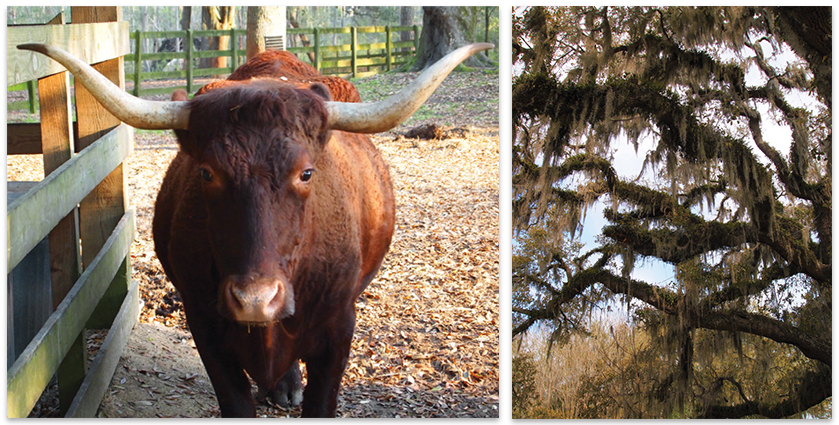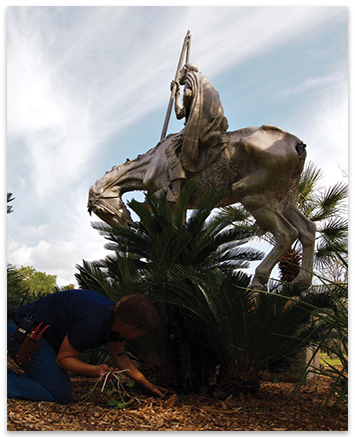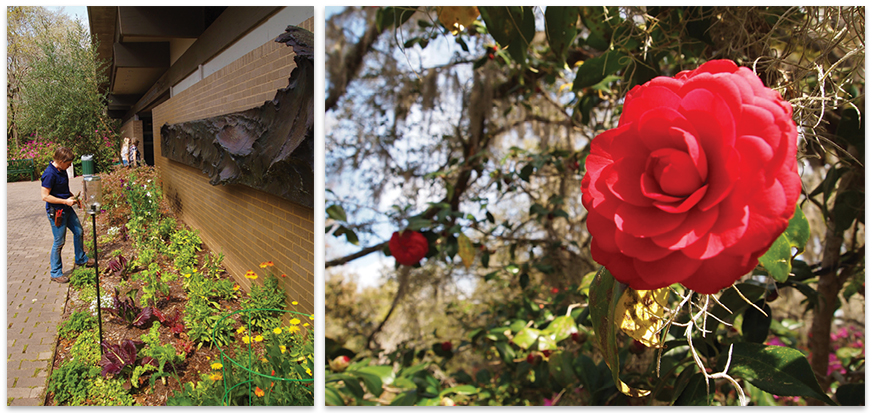A Day in the Life of a Brookgreen Gardens Horticulturist

In 1932, in the midst of the Great Depression, before Myrtle Beach was incorporated as a town and long before the Grand Strand would welcome 20 million visitors annually, a prominent New York City-based sculptor and her wealthy industrialist/philanthropist husband opened their shared vision—Brookgreen Gardens in Murrells Inlet, South Carolina.
When world-renowned sculptor Anna Hyatt Huntington and husband Archer purchased 9,100 acres made up of four former rice plantations, including one known as “Brookgreen,” plans for an elaborate sculpture garden began to take shape. Registered as a not-for-profit upon opening, Brookgreen Gardens, some 88 years later, still stays true to its mandate as “a society for Southeastern Flora and Fauna,” and to “collect, exhibit and preserve.”
More than 1,000 sculptures, many by Huntington herself and on permanent display, are situated throughout Brookgreen and share accolades with the carefully designed gardens. Tended by a team of 18 landscapers, gardeners, horticulturists and some 90 volunteers, Brookgreen Gardens is a highly revered cultural treasure and on the National Register of Historic Places.
As a part of our ongoing “A Day in the Life” series, we wondered about those tasked with making and keeping Brookgreen Gardens so beautiful, year-round. Recently spending the day with horticulturist Jamie Williams, a few of her coworkers and an army of volunteers, I was given an inside, behind-the-curtains peek and gained a better understanding of just how much work goes into the vision and mission Brookgreen honors so well.
7 a.m.
With the morning sun just peeking through the trees, dew glistens on the grass as a patchy mist dissipates over the lakes and grounds on the drive in from U.S. 17. I’m afforded a rare glimpse, as Brookgreen is not open to the public until 9:30 a.m. At this early hour, however, tom turkeys are doing their elaborate bird dance to a rafter (flock) of mostly disinterested hens as I drive toward the Carr Building, the center of all the horticulture planning and execution. I’m here to meet 43-year-old Jamie Williams, who’s already been on the job since 6:30 a.m., and who has worked at Brookgreen for nearly two years.
A former local landscaper and part-time server at Quigley’s Pint & Plate, Williams, a single mother of two, has the friendly, energetic face of someone who truly loves what they do. “I really do love coming to work,” she says. “It’s very satisfying to get your hands in the dirt.”
Williams is one of seven full-time horticulturists and works alongside landscapers, gardeners and the management team, all under the watchful, trusting eye of department head Katherine Rowe.
“We’re given a lot of [design] freedom,” says Williams, “but of course we have good communication, too, so we all hopefully know the plan.”

7:18 a.m.
Leaving the break room, coffee in hand, we’re joined by Jason Flynn, a fellow gardener/horticulturist and our work partner for much of the day. We’re headed toward one of the many motorized small flatbed utility vehicles designed to haul people, tools, plants and mulch all throughout Brookgreen.
With the help of a small bucket loader, Flynn loads the vehicle with the equivalent of 50 bags of mulch in a matter of minutes. By contrast, I recently needed 30 bags of mulch from the local home improvement store, and it took me three trips by car and an hour and a half just to load and unload. We’re headed to the Butterfly Pavilion, where a large team is already at work readying the attraction for its opening. (I would learn later, just before press time, that the Butterfly Pavilion will not open this year, due to the coronavirus pandemic. It was felt the pathways and entryways were not within social distancing guidelines. The rest of Brookgreen Gardens, is, as of press time, still open).
“We’re just helping here today,” says Williams, who’s found a comfy spot riding on top of the bulk mulch.
“Each horticulturist has his or her own areas,” she continues. “We’re in charge of weeding, planting and keeping them looking great. When we have time, we all help each other out, which is what we’re mostly doing today.”
7:30 a.m.
We swing by the volunteer meeting room in the Lowcountry Center to see who’s made it in. “Tuesday is our biggest day, and we’ll have up to 20 volunteers that come,” explains Williams.
Most of the volunteer crew is made up of retirees who trade much-needed light labor for admission tickets to many Brookgreen events. They haven’t yet arrived, so we move on.
We spend the next two hours beautifying an exhibit that has become a casualty of COVID-19.
“It caught us by surprise,” said Williams by phone, a week after my visit, “but I understand why.” We had spent several hours planting begonias and other plants loved by pollinators. “I have since dug up and replanted all those beautiful flowers somewhere else.”
Such is the chaotic, corona-mad work-world.
9 a.m.
Brookgreen hasn’t opened the gates quite yet, and the activity in our one small area is amazing. Volunteers have arrived, sun hats and gloves at the ready. They’re transplanting overgrowth outside the Butterfly Pavilion that the horticulturists feel spoils the aesthetic. Plant this, move that, weed there, rethink something else—it’s all in a busy day’s work.

9:51 a.m.
I take a moment to wander toward the adjacent Domestic Animals of the Plantation habitat, where a staffer tends to livestock. Bleating sheep follow the young woman and are clearly waiting for their morning nosh. Roosters crow while horses and cattle graze quietly. I’m reminded that Brookgreen Gardens is far more than just sculpture and pretty plants. Their accredited Lowcountry Zoo houses a wide variety of animals, and I overhear the staff buzzing about baby otters that had just been born.
10:05 a.m.
On the job for nearly four hours, it’s time for a break. Williams’ workday concludes at 2:30 p.m.
“I love the hours,” she says. “It gets me up early to see the best part of the day, and I still have all afternoon free to do other things and be with my [teenage] daughter after school.”
Williams’ 21-year-old son attends college locally. Among “other things” occupying Williams’ free time, are kickboxing for exercise and hot yoga two or three times a week. “I also do a lot of gardening at home,” she laughs. “Go figure.”
I ride shotgun with Flynn in the driver’s seat and Williams in the truck bed sitting on a piece of cardboard. They offer me a quick tour of the rest of the gardens. A longtime fan and regular visitor over the past 25 years, I never tire of the inspiring sculptures and gigantic centuries-old moss-draped trees along the magnificent Live Oak Allee. Having a guided tour makes this visit even more immersive. (Guided small group tours and creek excursion boat rides are available to the public and are highly recommended.)
We drive by the nearly complete, all new, outdoor artistic lighting installation by Bruce Munro, named Southern Light. Even in daylight, I can tell this nighttime exhibit will live up to the many amazing artistic installations Brookgreen has been known for over the years. Munro, an English/Australian artist, “plants” thousands of lights in changing patterns that come to life across whatever landscape he chooses as his palette, like “dormant seeds in the desert” that spring to life after a rain. Or, in this case, sunset.

10:33 a.m.
Flynn drops us off at the White Garden surrounding Diana of the Chase to finish our explorations by foot. He and the truck are needed elsewhere. The White Garden was designated by Huntington herself to be surrounded only by white flowers and white flowering shrubs. It is one of five sections assigned to Williams. She also oversees the Welcome Center, restaurant area, the Camellia Walk and Don Quixote.
“Spring and fall are the busiest seasons for us,” says Williams, who bends to pull an errant weed so small anyone else would have missed it, “but there’s a lot to do year-round. There’s never a dull moment and always something to be done.”
We walk through her other sections as she describes her vision, coming changes and the challenges of each. Her Don Quixote area surrounds the larger-than-life sculpture, completed by Huntington in 1947. It pops as an oasis of understated color and beauty, giving context to Quixote and faithful sidekick Sancho Panza’s arid but fertile Spanish La Mancha plateau, transporting you to central Spain.
“Some of the plants were there when I inherited this,” she says, “but we’ve spent a lot of time cleaning it up. We use mostly succulents here,” she says, “sago palms, sotol, there’s yuccas, agave, and palm trees, too. The Black Eyed Susans add some nice color. People tell me Don Quixote is one of their favorites.”

11:21 a.m.
Along the Camellia Walk, awash in color, we pick up fallen blooms, which can contribute to disease, and prune the browning blooms still on the trees. It’s one of the many reasons the gardens, even the very natural looking areas, are always at their best. Many of the camellias are from the original trees planted in 1931, and one purportedly dates back to the original plantation days.
Williams literally stops to smell the flowers from a native azalea and invites me to do the same.
“They smell so good,” she says. “I wish you could bottle that.”
“The gardenias will bloom all summer,” says Williams, as we walk along the shore of one of the largest lakes on the property, taking in at least a dozen turtles sunning themselves on a well-positioned log. “We have alligators, too,” she says, “and we let them stay unless they seem too interested in things they shouldn’t be. Our landscapers take a boat over to the island to keep things up over there, too.”

12:15 p.m.
We finish up our day at the hidden greenhouses, which are nurseries for so many of Brookgreen’s flowers and plants. Countless rows of seedlings fill tables in nearly all of the large greenhouses, and Brookgreen does its best to be as self-sufficient as possible.
Before we say our goodbyes, we step outside again. Color is everywhere and creates a stunning contrast against the evergreen plant base that otherwise dominates the gardens.
“Spring is spectacular here because of the azaleas and other spring bloomers,” says Williams, “but we’ve got lots of bloomers all summer long, too.”
Williams will finish her day shortly, and though, usually smiling, I sense an undercurrent of some anxiety.
She says she worries about the short-term future of Brookgreen Gardens and her workmates during these early days of the pandemic, though she’s optimistic and hopeful for the long-term.
She seems to find solace in her job, and that can be a rare thing.
“This so therapeutic, and so not a job,” she reiterates. “I just love it here.”
And so does everyone who’s ever visited.
In uncertain times and because of press deadlines, it’s best to call Brookgreen at (843) 235-6000 to get updated information before planning a visit. Interested in volunteering? Learn more and contact Brookgreen Gardens at brookgreen.org.